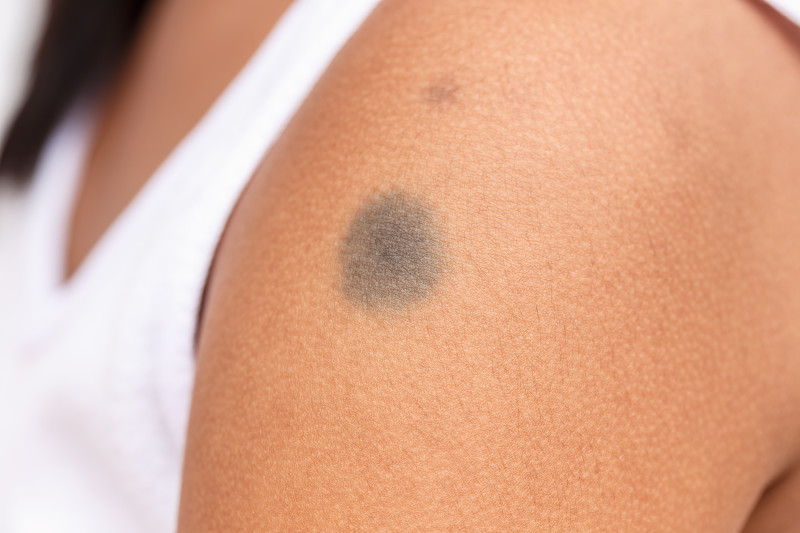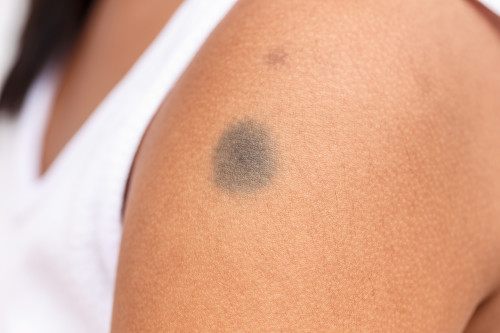 There are many types of skin cancers. Some lesions are small and fairly simple to excise. Some may leave only slight scars. However, other cancers are larger and may require a more complex and disfiguring excision to ensure that all the cancer is removed. Generally, most facial lesions are removed by a plastic surgeon to minimize scarring and leave the surgical site ready for reconstruction (if necessary). Among the most effective skin cancer surgical treatments is Mohs surgery, which can be disfiguring and nearly always requires reconstructive surgery.
There are many types of skin cancers. Some lesions are small and fairly simple to excise. Some may leave only slight scars. However, other cancers are larger and may require a more complex and disfiguring excision to ensure that all the cancer is removed. Generally, most facial lesions are removed by a plastic surgeon to minimize scarring and leave the surgical site ready for reconstruction (if necessary). Among the most effective skin cancer surgical treatments is Mohs surgery, which can be disfiguring and nearly always requires reconstructive surgery.
Dr. Chariker is highly experienced in reconstructive surgery following Mohs procedures. He employs a range of specialized reconstruction techniques to cosmetically improve or rebuild facial features disfigured by cancer surgery as well as to restore impaired functionality. He also performs primary skin cancer excision. Most insurance carriers cover the cost of reconstructive surgery.
Types of Skin Cancer
The primary cause of skin cancer is ultraviolet radiation from the sun, sunlamps, and tanning booths. The most common type of skin cancer is basal cell carcinoma, which tends to grow slowly and rarely spreads beyond its original site. Although seldom life-threatening, basal cell carcinoma can grow deep beneath the skin and into the underlying tissue and bone if left untreated. If left untreated, basal cell carcinoma can cause serious damage especially if it's located near the eye.
Squamous cell carcinoma is the next most common kind of skin cancer, frequently appearing on the lips, face, or ears. It sometimes spreads to distant sites, including lymph nodes and internal organs. It can become life threatening if not treated.
The least common skin cancer, malignant melanoma, is also the most dangerous and its incidence is increasing rapidly, especially in the Sunbelt states. If discovered early enough, it can be completely cured. If it's not treated quickly, however, malignant melanoma may spread throughout the body and is often deadly.
Two other common types of skin growths are moles and keratoses. Moles are clusters of heavily pigmented skin cells, either flat or raised above the skin surface. While most pose no danger, some may develop into malignant melanoma. Moles are frequently removed for cosmetic reasons, or because they're constantly irritated by clothing or jewelry. Solar or actinic keratoses are rough, red or brown, scaly patches on the skin. They are usually found on areas exposed to the sun and sometimes develop into squamous cell cancer.

|
Skin Cancer and MOHS Repair
Procedure Information
|
|
Surgical Treatments
Skin cancer is diagnosed by removing all or part of the growth and examining its cells under a microscope. It can be treated by a number of methods including surgery, depending on the type of cancer, its stage of growth and its location on your body. The different surgical techniques used in treating skin cancers can be life-saving, but they may leave you with scarring, disfigurement, or diminished function. Depending on the location and severity of the cancer, the consequences may range from a small but unsightly scar to permanent changes in facial structures such as your nose, ear or lip. Reconstructive techniques – ranging from a simple scar revision to a complex transfer of tissue flaps from elsewhere on the body – can often repair damaged tissue, rebuild body parts and restore most patients to acceptable appearance and function.

If the skin cancer is small, your physician can remove it quickly and easily in our outpatient facility or in his office, using local anesthesia. Depending on the individual case, the procedure may be a simple excision, which usually leaves a thin, barely visible scar. Sometimes the cancer may require your physician to perform curettage and desiccation, in which he scrapes out the cancer with an electric current to control bleeding and kill any remaining cancer cells. This leaves a slightly larger, white scar.
If the cancer is large, however, or if it has spread to the lymph glands or elsewhere in the body, it likely will require major surgery, which would be performed by a physician specializing in these types of cancer surgeries. One of the surgical techniques that generally requires reconstruction is Mohs surgery, in which minute layers of skin tissue are meticulously removed and examined under a microscope. By removing thin layers of tissue in this incremental manner, the physician can be sure that all involved tissue is excised and can simultaneously spare healthy tissue. This highly effective skin cancer surgery has a success rate approaching 99 percent and is performed by specialized surgeons who only perform the skin cancer removal. They then refer their patients to a facial plastic surgeon such as your physician for reconstruction.
Reconstruction – Mohs Repair
Mohs surgery is now frequently used to remove basal cell carcinomas, squamous cell carcinomas and other lesions on the face. After a malignant lesion is removed with Mohs surgery, a depression or hole in the skin remains. your physician may perform reconstructive surgery immediately after Mohs surgery to repair the damaged site, carefully reconstructing the facial tissue and restoring the skin’s natural appearance.
your physician will assess the post-surgical wound and the best reconstructive approach. On small defects, when the scar can be hidden in a wrinkle line, your physician may simply stitch together the skin edges with sutures. This can give excellent results.
Many larger surgical defects can be repaired with skin flaps. In this procedure, the doctor uses nearby or adjacent skin to cover or “flap” over the wound. This often provides excellent cosmetic results due to the match of skin texture, consistency and color. Sometimes your physician may use a skin graft on certain parts of the face. A skin graft involves removing a piece of skin from a donor site and then sewing it into the Mohs defect. Donor sites are typically chosen from areas with excess skin in inconspicuous locations, such as behind the ear.
However, sometimes more complex or multiple-staged reconstruction is required, depending upon how much tissue is removed, whether other tissue such as cartilage and bone must be reconstructed and replaced and whether function is impaired. your physician has extensive experience in these more complex surgeries.
Warning Signs and Prevention
You should consult with your doctor if you see any change in your skin, such as a growth, an irritation or a sore that does not heal, or a change in a wart or a mole. These could be early signs of skin cancer. Suspicious lesions on the face should be removed by a qualified plastic surgeon.
Signs of melanoma in a mole:
- Asymmetry and border irregularity – half of a mole doesn’t match the other half, or the edges of a mole are ragged, notched or blurred.
- Color – mole pigmentation is not uniform. Shades of tan, brown and black are present. Dashes of red, white and blue add to the mottled appearance. Changes in color distribution, especially the spread of color from the edge of a mole into the surrounding skin, also are an early sign of cancer.
- Change in size – any growth of a mole should be of concern and so should the thickening or raising of a previously flat mole.
- Surface – scaling, erosion, oozing, bleeding, crusting, or softening.
- Surrounding skin – redness, swelling, or small new patches of color around a larger lesion (satellite pigmentations).
- Sensation – itching, tingling, or burning.
Other signs of skin cancer include:
- A firm, transparent bump laced with tiny blood vessels in thin red lines.
- A reddish or irritated patch of skin.
- A new, smooth skin bump (nodule) with a raised border and indented center.
- A smooth, shiny, or pearly bump that may look like a mole or cyst.
- A shiny area of tight-looking skin, especially on the face, that looks like a scar and has poorly defined edges.
- An open sore that oozes, bleeds, or crusts and has not healed in three weeks.
- A persistent red bump on sun-exposed skin.
- A sore that does not heal or an area of thickened skin on the lower lip, especially if you smoke or use chewing tobacco, or your lips are exposed to the sun and wind.
Prevention of skin cancers is straightforward and simple:
- Avoid unprotected exposure to the sun during peak radiation times (the hours surrounding noon).
- Wear a broad-brimmed hat and tightly-woven protective clothing while outdoors in the sun.
- Regularly use a waterproof or water-resistant sunscreen with UVA protection and SPF number of 30 or higher.
- Undergo regular checkups and bring any suspicious-looking or changing lesions to the attention of your doctor.